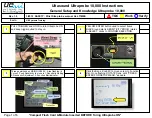
Controlling the Acquisition of Data > Using Triggers to
Capture Just What You Want > Triggering
Triggering
Triggering
The spectrum analyzer has two triggering modes: Free Run and Triggered.
Free Run
In Free Run mode, the instrument initiates acquisitions without considering any trigger conditions. It is a
fast and easy way to see the signals. Free Run is usually adequate for the Spectrum display unless you
need to specify a particular time at which to collect the data record.
Triggered
In the Triggered mode, the instrument initiates an acquisition when a trigger event is recognized. The
conditions that de
fi
ne a trigger event depend on the selected trigger source. There are several source
selections available for choosing the signal to monitor for a trigger event. If the RF input is the selected
trigger source, you can choose to use power, frequency mask triggering, DPX Density (Option 200), or
Runt (Option 200) as the trigger types. If other inputs are selected as the trigger source, you can select the
slope and level of the trigger point. With the Gated source, you also specify the gating signal level.
Power level triggering.
Power Level triggering triggers the instrument on time-domain signal transitions.
The incoming data is compared to a user-selected level in dBm. You can select the time-domain bandwidth
and trigger on the rising or falling edge.
Frequency mask triggering (Option 02).
Frequency Mask Triggering allows you to trigger the instrument
when a signal in the frequency domain violates the mask. You can draw a mask to de
fi
ne the conditions
within the real-time bandwidth that will generate the trigger event. It allows you to trigger on weak signals
in the presence of strong signals. This triggering is also useful for capturing intermittent signals.
DPX density triggering (Option 200).
DPX Density triggering uses characteristics of the DPX Spectrum
display to specify trigger parameters. When using DPX Density triggering, the percentage of time the
signal falls within the measurement box is used to de
fi
ne a trigger event. The measurement box is de
fi
ned
by frequency and amplitude values.
Runt triggering (Option 200).
Runt triggering allows you to de
fi
ne a trigger event based on a pulse
amplitude that crosses one threshold but fails to cross a second threshold before recrossing the
fi
rst.
You can de
fi
ne the following event parameters by selecting the respective tab in the Trigger control panel:
Event source, event type, and event de
fi
nition.
Time parameters that de
fi
ne what portion of the data record is used for pretrigger samples and whether
to delay the trigger for a set amount of time after the recognized event.
Advanced parameters de
fi
ne where a trigger occurs within the acquired memory or trigger each
segment in the swept acquisition mode.
RSA6100A Series Real-Time Spectrum Analyzers Help
317
Summary of Contents for RSA6100A Series
Page 2: ......
Page 12: ...Table of Contents viii RSA6100A Series Real Time Spectrum Analyzers Help...
Page 28: ...Orientation Elements of the Display 16 RSA6100A Series Real Time Spectrum Analyzers Help...
Page 307: ...Search Limits Testing Define Tab Search RSA6100A Series Real Time Spectrum Analyzers Help 295...
















































